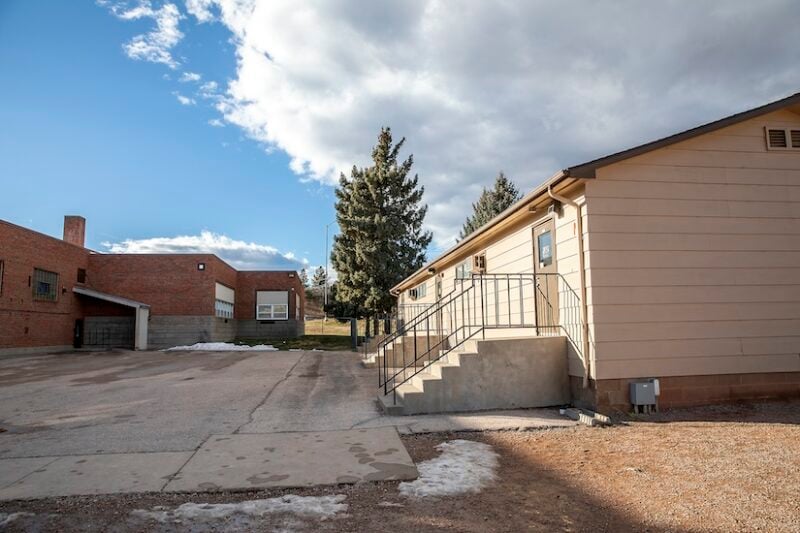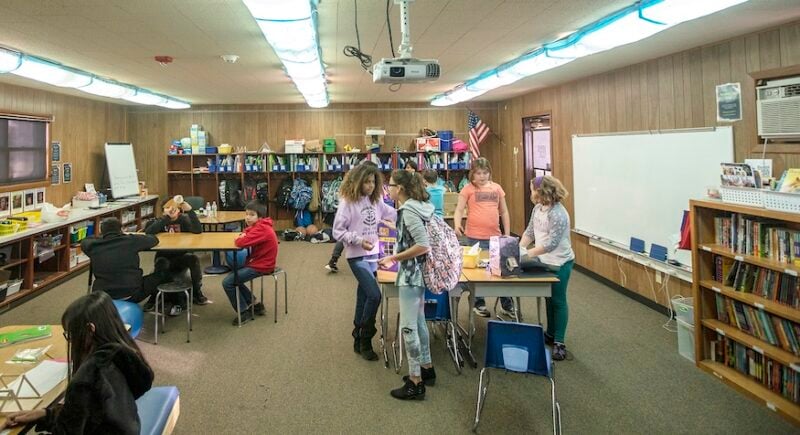How School Portables Became Permanent Classrooms

A portable classroom at Rock Creek Elementary School in Washington County, Oregon. (Source)
Updated October 2, 2024
February 21, 2020 ~ By Shari Rose
Many of us as children in school have spent time learning within the four plywood walls of a classroom portable. True to their name, school portables can be very useful to school districts in a pinch that desperately need new classrooms. With rapid-construction techniques and relatively lower costs than other options, portables offer fast relief to school districts staggering under ballooning student populations, but they were never designed to be permanent. What were once quick fixes for temporary classrooms are now permanent structures in schools across the U.S. And unless priorities surrounding education funding shift in a major way, classroom portables are here to stay – for better or worse.
- Why Do Schools Have Portables?
- Studies into the Effects of School Portables on Students’ Health
- Relationship Between Classroom Portables & Academic Performance
- Do State Laws Apply to School Portables?
- Some Decades-Old School Portables Remain Permanent Classrooms
Why Do Schools Have Portables?
The main purpose of school portables, also called modular classrooms or prefab buildings, is to serve as temporary classroom space, particularly when school capacity cannot keep up with influxes of new students. Most portables are built with plywood and insulation materials, and school districts typically have the power to choose the prefab school building manufacturer they would like to supply their portable classrooms.
Not intended for use as permanent campus structures, decades-old school portables are commonplace in American schools from coast to coast. Shrinking school budgets and growing student populations, as well as local-level bond failures at the ballot box to address these issues, have created conditions that make classroom portables as permanent as the brick-and-mortar school itself.

Two classroom portables face other school buildings at Canyon Lake Elementary School in Rapid City, SD. (Ryan Hermens/Rapid City Journal via AP)
For example, school portables at the Los Angeles Unified School District account for 30% of all available classroom space in the district, or about 8,300 portables total.
Former LAUSD Chief Facilities Executive Mark Hovatter sounded the alarm in 2015, saying to the school board that portables “are supposed to be temporary in use, and we might have stretched the definition of what temporary means in our case, but certainly the intent was not to be a permanent facility.”
So, what exactly are the effects of portable classrooms on students and teachers, and who is in charge of regulating these structures as they age?
Studies into the Effects of School Portables on Students’ Health
Despite the popular use of portables in schools, just a small handful of studies in the last 20 years are dedicated to understanding the effects of portables on student health. Much of the data gathered about California schools below is taken from a 2004 study into portable classrooms by the California Air Resources Board, and arguably remains the most comprehensive study of its kind today. Measurable health effects caused by school portables include:
Ventilation problems
The 2004 study flagged portable classrooms for failing to provide adequate fresh air during 40% of teaching hours where children were present, a ventilation concern made all the more pressing 20 years later with regard to COVID-19. In this study, carbon dioxide levels rose to thresholds where student performance can suffer. Other studies have found that increases in carbon dioxide levels can significantly impair decision-making and other executive functions.
Extreme noise levels
Often, noise is a major complaint for teachers and students alike in school portables. The loud HVAC system, thin walls that do not effectively block outdoor sounds, and noisy aluminum walkways that announce to everyone in class that a visitor is imminent, there are a lot of noise distractions in classroom portables. These conditions naturally detract from the effectiveness of the lesson that’s being interrupted and can cause general distractions throughout the day.

Fourth grade students work on their projects inside a school portable in South Dakota. (Ryan Hermens/Rapid City Journal via AP)
Potentially unsafe building materials
Insulation foam, plywood, different types of glues and particle boards are what typically make up the walls of the average portable classroom in use today. In the 2004 study, portables were found to have “higher levels of formaldehyde” that exceeded state exposure limits in the vast majority of school portables studied. This chemical can be commonly found in cheap building materials, and is linked to childhood asthma and other conditions.
Another potential health concern of portable classroom building materials is chemical off-gassing from pressed wood and other volatile materials. The EPA has flagged this in particular as a health concern because turnaround times from finished construction to student occupancy for portable classrooms tend to be quite quick.
Safety risks during an emergency
A 2001 study that measured how school facilities can impact a child’s education found that portables are often placed farther away from important buildings, such as bathrooms, the gym, the cafeteria, and administrative offices. This requires students to walk in relatively empty areas that are less supervised and can be harder to reach, especially in an emergency situation.
- More stories: Wheelchairs & Airlines: Why Is Flying So Risky for Those With Disabilities?
- More stories: America Has The Highest Maternal Mortality Rate Among Western Nations
- More stories: George Washington’s Fight for Smallpox Inoculation in 1775
Relationship Between Classroom Portables & Academic Performance
Beyond the health effects portable classrooms may have on teachers and students alike, studies have found negative trends with student performance and the use of portables.
A 2009 study completed by Texas Tech University focused on the question of how school facilities can impact student academic success in the state of Texas by measuring TAKS scores. Short for the Texas Assessment of Knowledge and Skills, TAKS is the state’s standardized test taken by thousands of students every year.
This study found that reducing the number of school portables in rural high schools had a positive effect on student test scores: “For every 10 percent reduction in the percent of portable square feet per student of school facilities, the average TAKS scores increased by 11.38 points and the average years of teacher experience with the district increased by 2.32 years.”
In addition, higher percentages of portable classroom usage were associated with higher rates of teacher turnover. The 2009 study also found high schools that used the largest percentages of permanent school portables also had some of the largest numbers of low-income and minority student populations.
Do State Laws Apply to School Portables?
While many state laws across the U.S. have established standards for proper air quality, construction materials and more for use in public school buildings, those laws do not apply to school portables. Currently, no state laws regulate the use of classroom portables in schools. Some states do offer recommendations of some form or another, but there are no legal requirements for how many portables school districts are allowed to use, how many years they can use them, and so on.
Some states, such as Washington state, require that construction materials used to build a new school meet certain standards, such as environmental rules that must be followed to qualify for state funds. School portables, once again, are excluded from those rules.
- More stories: How SSI $2,000 Limit Keeps Those with Disabilities in Poverty
- More stories: How a Retractable Syringe Exposed Powerful Group Purchasing Organizations (GPOs)
- More stories: Prison Gerrymandering Is a Modern 3/5 Compromise
Private manufacturers of modular buildings and portable classrooms offer upgradable options that school districts can take advantage of, including improved HVAC systems and non-toxic building materials. However, those options cost more money. And for a school district that’s already strapped for cash, modern upgrades to aging school portables aren’t in the budget.
In fact, the choice between saving money and purchasing portables with updated features is so commonplace for school districts that the EPA explicitly addresses this dilemma on its website. The agency recommends that “care should be taken during specification and selection to ensure that the students’ health is not compromised for inexpensive, low quality designs.”
Some Decades-Old School Portables Remain Permanent Classrooms
What’s yet another issue looming over the use of school portables? They’re aging. And many school districts don’t replace them in a timely fashion.
For example, at the Beaverton Unified School District in Oregon, 40% of all portable classrooms are at least 20 years old. The oldest was built in 1969 and the 55-year-old school portable still functions as a 4th-grade classroom. That being said, voters did approve a bond measure that allows the Beaverton school district to build 3 new schools and expand others.
Other school districts tried and failed to get bond measures passed that would negate the need for future permanent classroom portables. For instance, a bond measure in 2008 would have allowed Evergreen to construct 3 elementary schools, a middle school, and more educational facilities. However, voters rejected the measure. Out of money and out of options, Evergreen Public Schools had no choice but to add more than 100 school portables to its campuses instead.






0 Comments